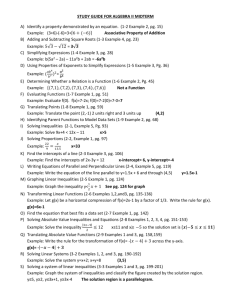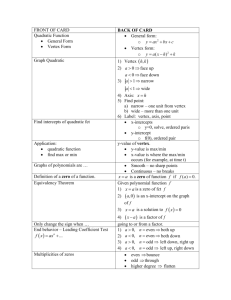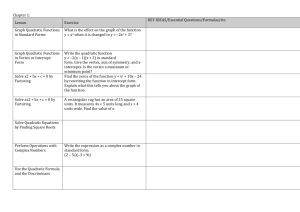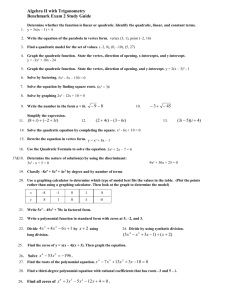Midterm Topics
advertisement
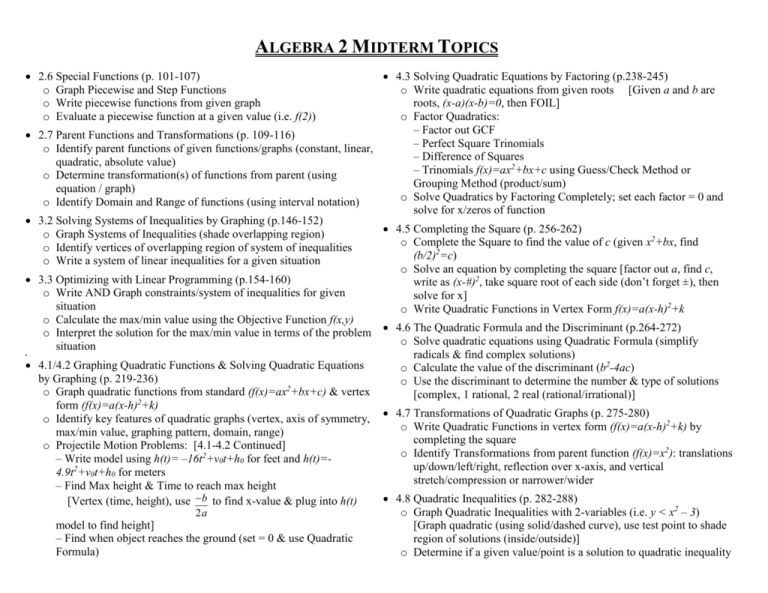
ALGEBRA 2 MIDTERM TOPICS 2.6 Special Functions (p. 101-107) o Graph Piecewise and Step Functions o Write piecewise functions from given graph o Evaluate a piecewise function at a given value (i.e. f(2)) 4.3 Solving Quadratic Equations by Factoring (p.238-245) o Write quadratic equations from given roots [Given a and b are roots, (x-a)(x-b)=0, then FOIL] o Factor Quadratics: – Factor out GCF 2.7 Parent Functions and Transformations (p. 109-116) – Perfect Square Trinomials o Identify parent functions of given functions/graphs (constant, linear, – Difference of Squares quadratic, absolute value) – Trinomials f(x)=ax2+bx+c using Guess/Check Method or o Determine transformation(s) of functions from parent (using Grouping Method (product/sum) equation / graph) o Solve Quadratics by Factoring Completely; set each factor = 0 and o Identify Domain and Range of functions (using interval notation) solve for x/zeros of function 3.2 Solving Systems of Inequalities by Graphing (p.146-152) 4.5 Completing the Square (p. 256-262) o Graph Systems of Inequalities (shade overlapping region) o Complete the Square to find the value of c (given x2+bx, find o Identify vertices of overlapping region of system of inequalities (b/2)2=c) o Write a system of linear inequalities for a given situation o Solve an equation by completing the square [factor out a, find c, 3.3 Optimizing with Linear Programming (p.154-160) write as (x-#)2, take square root of each side (don’t forget ±), then o Write AND Graph constraints/system of inequalities for given solve for x] situation o Write Quadratic Functions in Vertex Form f(x)=a(x-h)2+k o Calculate the max/min value using the Objective Function f(x,y) o Interpret the solution for the max/min value in terms of the problem 4.6 The Quadratic Formula and the Discriminant (p.264-272) o Solve quadratic equations using Quadratic Formula (simplify situation radicals & find complex solutions) 4.1/4.2 Graphing Quadratic Functions & Solving Quadratic Equations o Calculate the value of the discriminant (b2-4ac) by Graphing (p. 219-236) o Use the discriminant to determine the number & type of solutions o Graph quadratic functions from standard (f(x)=ax2+bx+c) & vertex [complex, 1 rational, 2 real (rational/irrational)] form (f(x)=a(x-h)2+k) o Identify key features of quadratic graphs (vertex, axis of symmetry, 4.7 Transformations of Quadratic Graphs (p. 275-280) 2 o Write Quadratic Functions in vertex form (f(x)=a(x-h) +k) by max/min value, graphing pattern, domain, range) completing the square o Projectile Motion Problems: [4.1-4.2 Continued] o Identify Transformations from parent function (f(x)=x2): translations – Write model using h(t)= –16t2+v0t+h0 for feet and h(t)=up/down/left/right, reflection over x-axis, and vertical 4.9t2+v0t+h0 for meters stretch/compression or narrower/wider – Find Max height & Time to reach max height 4.8 Quadratic Inequalities (p. 282-288) [Vertex (time, height), use -b to find x-value & plug into h(t) o Graph Quadratic Inequalities with 2-variables (i.e. y < x2 – 3) 2a model to find height] [Graph quadratic (using solid/dashed curve), use test point to shade – Find when object reaches the ground (set = 0 & use Quadratic region of solutions (inside/outside)] Formula) o Determine if a given value/point is a solution to quadratic inequality 5.7 Roots and Zeros (p.358-365) o Find roots/zeros/x-intercepts of given polynomials: use synthetic division for given zero(s), factor depressed polynomial to determine remaining zero(s) o Graph polynomials using end behavior and ALL zeros with 5.1 Operations with Polynomials (p.303-309) multiplicities o Multiply, Divide & Simplify expressions using Exponent Properties o Multiply Polynomials using the Distributive Property 6.1 Operations on Functions (p.385-392) o Add, Subtract, Multiply and Divide Functions 5.2 Dividing Polynomials (p.311-317) o Compose functions [f(g(x)) or g°f (x)] o Divide polynomials using Long Division o Identify restrictions on the domain of functions and write in interval (write remainders as fractions) notation o Divide polynomials using Synthetic Division (4.8 continued) o Solve Quadratic Inequalities in 1-variable (i.e. x2 –2x – 3 ≥ 0) [Factor, find zeros, plot on number line using open/closed circles, determine shaded region(s), answer using interval notation] (write quotient as polynomial) 5.3 Polynomial Functions (p. 322-329) o Write polynomials in Standard Form & Identify Degree and Leading Coefficient o Determine End Behavior of polynomials (+ odd, - odd, + even, even using infinity notation) o From graph of function, determine # of real zeros & end behavior o Identify zeros and their multiplicity (from graph) 5.4 Analyzing Graphs of Polynomial Functions (p. 330-337) o Identify turning points, relative maximums and minimums and zeros of a function from its graph o Use Graphing Calculator to find values of zeros & relative max./min. values o Identify increasing / decreasing intervals on graph of polynomial o Identify domain & range using interval notation 5.5 Solving Polynomial Equations (p.342-349) o Factor polynomials using GCF, diff of squares, sum/diff of cubes, grouping, quadratic form o After factoring, set each factor/piece =0 and solve for all values of x (real and complex) 5.6 The Remainder and Factor Theorems (p. 352-357) o Use synthetic division to determine whether (x – #) is a factor of the polynomial o Given a factor/zero of a polynomial, write polynomial in factored form and find all zeros 6.2 Inverse Functions and Relations (p.393-399) o Find inverse relations/functions from given points o Graph inverse functions/relations o Find inverse functions/relations from given functions (switch x/y & solve for y) o Verify inverses using composition of functions

